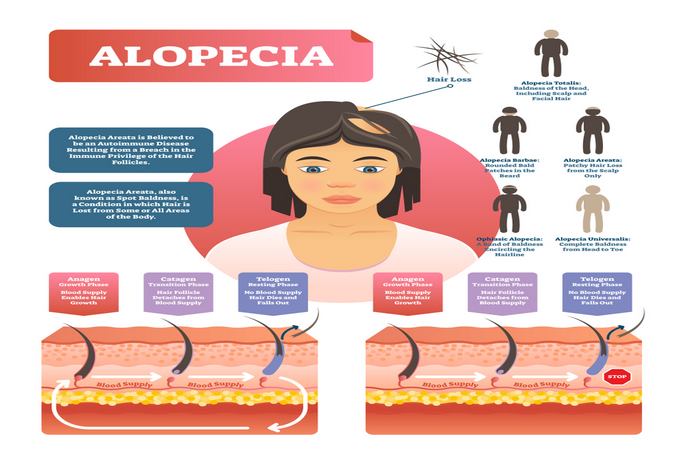Types Of Alopecia Areata
There are several types of alopecia areata, depending on the extent of hair loss, body part affected, and severity of the disease. Each type has a minor change in treatment and symptoms. In all types of the disease, hair follicles do not lose all of their functions and can restart the hair production when they receive signals for hair growth. In some cases, hair begins to regrow even without any sort of treatment and sometimes hair growth resume after some years. Common types of alopecia areata are:
- Patchy alopecia areata
- Alopecia totalis
- Alopecia Universalis
- Diffuse alopecia areata
- Ophiasis alopecia
- Persistent alopecia areata
Patchy alopecia areata:
This type is the most common type of alopecia areata. In medical terminology, alopecia means baldness, and areata refers to patches. In this type of the disease, a person experiences hair loss in the form of coin-sized patches on the scalp. This type can lead to other types as the disease progresses. If hair loss occurs in full-body, this condition will become Alopecia Universalis. And if this affects the entire scalp, known as alopecia totalis. Although the scalp is the most affected area, hair loss can occur on the ears, inside the nose, armpits, eyelashes, eyebrows, head, legs, or any part of the body. The patches formed in various sizes and smooth to touch.
Alopecia totalis:
Alopecia totalis is the 2nd most common type of alopecia areata. In this disease, a person suffers hair fall on the entire scalp. This disease leads to complete baldness of the scalp. This condition can occur in two phases. There may be quick hair loss in the head, scalp, eyebrows, eyelashes, and face. And there is a possibility that patches formed initially and then led to complete baldness by joining of these patches as new patches formed. This condition may be challenging for some people as people will feel less confident in their everyday life.
Alopecia Universalis:
Although it is a less common type of Alopecia Areata, the signs and symptoms it has are no less severe than the two most types mentioned above. As the disease progresses, alopecia areata can convert into alopecia Universalis in which a person suffers hair loss on the entire body. This disease is an advanced form of alopecia totalis, and hair loss may occur on the entire body, including the chest, arms, back, and pubic region. This condition is not very common, and such patients need special care to protect them from infections and extreme weather.
Diffuse alopecia areata:
This type does not include the formation of patches due to hair fall. In diffuse alopecia areata, the individuals feel a sudden thinning of hair over the scalp. This condition may be challenging to diagnose as it does not include the symptoms like other forms of alopecia areata. The signs and symptoms are much similar to other types of hair fall, i.e., due to medications or other treatments.
Ophiasis alopecia:
In this type, the hair loss occurs in the shape of a band on the head. The area of hair fall includes the sides and lower back portion of the scalp, also known as the occipital region. The treatment of ophiasis alopecia is difficult than other types because it has a unique pattern of hair fall and does not quickly respond to the treatment.
Persistent patchy alopecia areata:
This type is less common and mostly occur in specific ethnicities. It is known as persistent patchy alopecia areata because this does not convert into other forms, i.e., alopecia totalis and alopecia Universalis. The symptoms are similar to patchy alopecia areata, but it continues for a long time and form patches on the skin.

